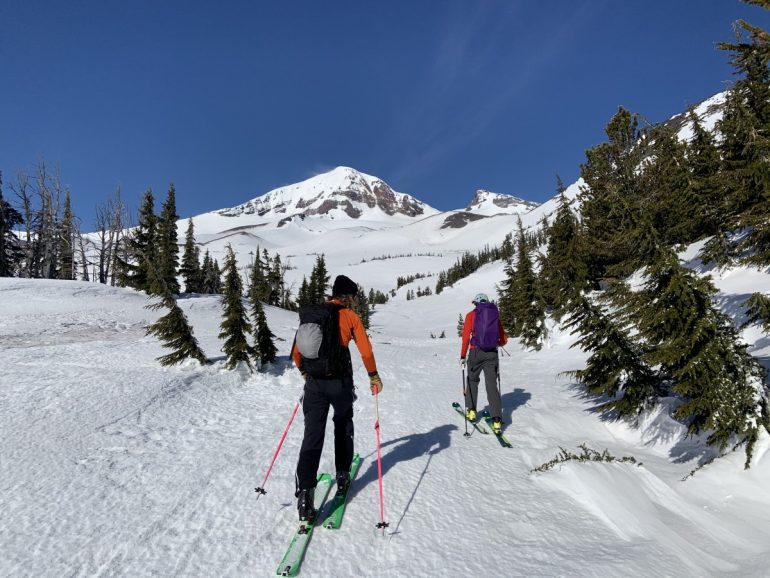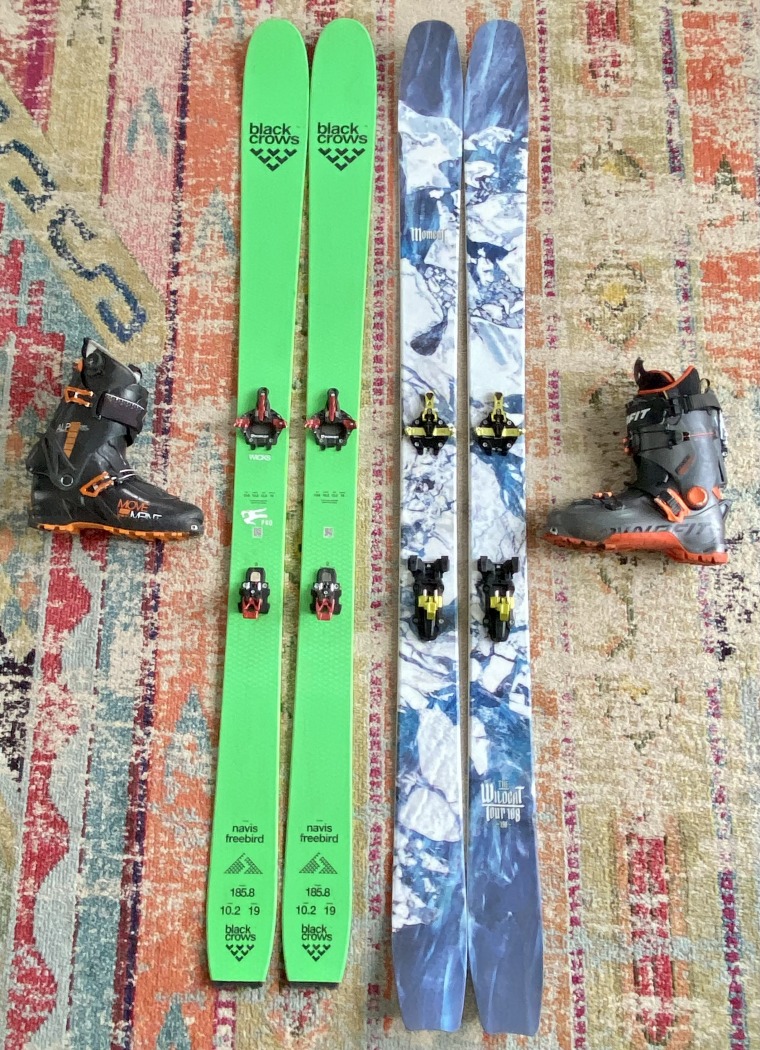“Downcountry” is a term recently coined by a prominent member of the cycling journalism world to describe mountain bikes that are slightly more than an XC bike, but not a full-on enduro or trail bike. The premise of this category creation is that mountain bikers have gravitated towards bikes that ride exceptionally well on the descents but are still manageable on all-day epics. This minute splitting of bike categories based on weight, suspension travel, and geometry might seem ridiculous to the outside world, but backcountry skiers can likely relate.
Ski marketing copy, especially backcountry-specific material, often tosses around the terms “ultimate quiver of one” or “quiver killer”. And for good reason. Many skiers are constantly looking for that light on the uphill, fun to ski in all conditions on the downhill, unicorn shred stick. The ability to dole out exciting descents while not totally crushing your legs on the way up is the golden goose of pretty much any human-powered sport.
Given the variability in location-dependent ski conditions and skier size and style, it is impossible to define the ultimate “one quiver ski” for everyone. For example, I am 6’5” and 190 lbs, so my ideal setup will look different from my friend James who is 5’8” and 140 lbs. There’s variability in a personal ideal. Still, if we look to the mountain bike world for a model, a few trends begin to stand out.
For me to have the most fun in the backcountry, a ski that can keep me on my feet, charge when desired, and not drain the tank on the uphill serves me best. I believe the ultimate “downcountry” ski setup for me is in the mid-curve sweet spot, right in the center of the spectrum – kind of like my mountain bike choice since my days of racing have expired. Maybe we are reaching a point where ski technology will give us a sub-1000 g ski that can shred crud, hold an edge on rime ice, and float in champagne powder; maybe. Since my experience is in the two-wheeled world, I reached out to some ski industry designers and insiders for their take on the direction of backcountry ski development.

120mm front and rear. According to the author, Downcountry in its purest form. Does backcountry skiing have an equivalent?
“The joke is ‘Skimo is neither’ as in, it’s neither skiing or mountaineering,” said Fasa Nelson of Moment skis. “We’ve been working hard on developing our touring line of skis, and in the process of weight reduction, we’ve been able to discover a whole lot about what makes a ski perform the way it does. Things that were hiding behind the weight and damping of a resort ski come to the fore when we try and make the ski light. By stripping weight, we expose weaknesses that we can then address with ski geometry and construction technique. Our goal with the touring line is to make a ski that mimics the resort experience as much as possible, but is lighter weight for the uphill.”
As a brand, Dynafit is as close to an eponym as we get. We tend to associate Dynafit with the fast and light side of the sport, which Ross Herr, director of sales and marketing for Oberalp, a company associated with Dynafit, acknowledges.
“Dynafit gets pigeonholed into the kind of fast and light experience,” said Herr. “But what Dynafit does is they look at the whole package, head to toe, where we acknowledge there’s a diminishing return on, say, carbon lightweight skis. So what is the balance that you can find on the ski? We’re not going to build the Blacklight 95 ski lighter than its 1300g package that it’s at today. We think that that is a good balance.”
The operative word, I think, is balance. And Herr said some skiers are opting for heavier ski-boot-binding setups than they may need. However, he sees a trend where skiers are focused on weight reduction and comfort when it comes to helmets, backpacks, and clothing – those other parts of the winter travel system.
Herr said a guiding question at Dynafit is, “where can you look to make your whole package lighter, not only looking at one single dimension?”
Maybe the “lighter is better” ethos of ski construction is under some pressure and heavier skis can be complemented with a lighter binding, skin, and boot.
K2, a legendary company with deep ski racing roots thanks to Phil and Steve Mahre, long ago bridged the gap from heavy skis, into functional tools on the ups and downs. Over the years, they have engineered both damp and feather-like characteristics into their skis. The 2010-2011 Wayback 88 came in at 1460g in 167cm. According to WildSnow, by 2017, the average Wayback 88 was 1384 grams in a longer length – 174cm. I’d say it’s right there in the juicy part of the ski-weight-performance metric.
“Historically, the touring market has been broken into two camps, not unlike the bike market,” said Jed Yeiser, a ski designer at K2. “On one side of the spectrum, you have the – traditionally European – ski randonee customer who is focused on lightweight above all else. That focus has nothing to do with ski performance. While some of these customers actually do need uber lightweight skis, the vast majority of them simply are trained to believe that the lighter a ski is, the more technologically advanced it is and the better it is. That customer still exists and isn’t going anywhere. On the other end of the spectrum, you have customers who will walk uphill with extremely heavy, inefficient equipment.”
Yeiser explains that both camps, the light ski and the heavy ski armies, can find some common ground.
“Historically, these have been younger, stronger skiers who make these equipment choices because they are not willing to make any compromises on the way down. There’s a pervasive belief in this group that the lighter a ski is, the worse it is. Like their counterparts in the ultralight camp, they’re mistaken. There is a relationship between ski weight and ski performance, but it’s non-linear and has a great deal of scatter. In much the same way that the ultra-light customer will not be convinced that a heavier ski will meet their needs better, these customers will not be convinced that lighter, touring specific, equipment will meet their needs better.”
Unlike Dynafit’s lightweight gear chops, K2 originally approached the ski design equation from their on-piste (read heavier) DNA.
“There has always been a market for ‘heavier’ touring skis, and it’s one that K2 – in particular – has focused on. Making a ski lighter is not a difficult undertaking, and we have always felt that there is a ‘sweet spot’ where making the ski lighter will have adverse effects on performance. Much of our development centers around finding the weight at which performance starts to degrade rapidly. One of our most successful touring skis of all time, the original Coomback, was approximately 1800g, far heavier than any other ‘touring’ ski at the time. One of the primary reasons that ski was so successful in the touring market is that it delivered high-end descending performance at a weight that was low enough for large tours.”
In Yeiser’s estimation, the transition is underway – companies are producing skis that more closely resemble the characteristics of resort-style skis. Read this as heavier and damper; not the lean stuff, not the fatty stuff, but the juicy middle.
The juicy center of the backcountry ski equipment curve is a real hot spot, and that is where many companies are focusing their attention. Where do you think ski development should head? Where do you draw the line on the weight to performance spectrum? Things are likely to progress as designers push ski development towards the ultimate goal of high fives and stoke.
Barry Wicks, also known as @wicknasty, demphasizes the nasty and embraces the kindness. He lives in Bend, Oregon where in a parallel universe he covets all things cycling. And although he might not admit it, some say he was once quite speedy on a bike. Also, amongst WildSnow writers, he has the best hair.


